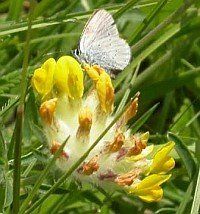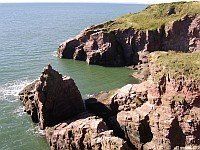Seaton Cliffs


near Arbroath, NO 667 416 O.S. Sheet 54
There is a new path at Seaton Cliffs and the old path should be avoided due to the danger of further erosion.
Overview
Seaton Cliffs extends over 12ha of unimproved grassland behind red sandstone cliffs.
A number of notable plant species can be found within the reserve and it is nationally important for wintering purple sandpiper.
Spectacular cliffs of rich red sandstones and conglomerates make Seaton Cliffs a colourful spot at any time of the year. Over the 350 million years since they were deposited, these rocks have been subjected to the immense forces of the sea. The many sea caves and stacks are the result of relatively recent erosion, which is still continuing today. The line of the cliffs is broken by gentler slopes covered with luxuriant vegetation, and at Seaton Den thick woodland in the gorge contrasts with the bareness of the exposed cliff top.
Wildlife
Seaton Cliffs support a wealth of flowering plants. Where springs create marshy conditions on the gentler slopes, plants such as meadowsweet and marsh- orchid grow alongside woodland flowers like primrose and violet. Sea campion and other truly maritime species, such as purple milk-vetch, are also present. In some places the soil is sufficiently lime-rich to support clustered bellflower and carline thistle - both plants more commonly found in the chalk lands of southern England. All these plants survive here because they are protected from cultivation and grazing animals.
The diverse cliff-top vegetation attracts a variety of insects. Colourful six-spot burnet moths and several species of butterfly visit the flowers along the nature trail, and solitary mining bees burrow in the sandy path-side banks. There is also a large population of banded snails, mainly concentrated in the damper, lime-rich areas. Rock doves nest in the sandstone caves and house martins build their mud nests beneath the overhangs. There are not many ledges on these cliffs so comparatively few seabirds nest on the reserve. However, a few fulmars and herring gulls nest both on the cliffs and on the stacks offshore. During the summer arctic terns fish and eiders dive for mussels below the cliffs, and there are usually gannets further out to sea. At low tide waders feed over the exposed flat shelves of weed-covered rock, which are dotted with shallow pools rich in marine life.
Conservation
The walk along the sea cliffs and through the reserve is very popular and the pressure of large numbers of visitors has caused erosion of the cliff-top vegetation in some areas. Scrambling motorcyclists are especially destructive; to keep them out vulnerable sections of the reserve have been fenced. Other conservation work is focused on maintaining the Nature Trail and on tree planting in Seaton Den.
Warning
Please keep to the cliff paths at all times - the cliffs are extremely dangerous.
Access to the Reserve
Seaton Cliffs are 1km from the centre of Arbroath at the north end of the promenade. There is ample parking at the promenade and a good path leads to the reserve.
A guide is available in "
Z-fold " form for printing or in
paged form for use on a mobile device.

